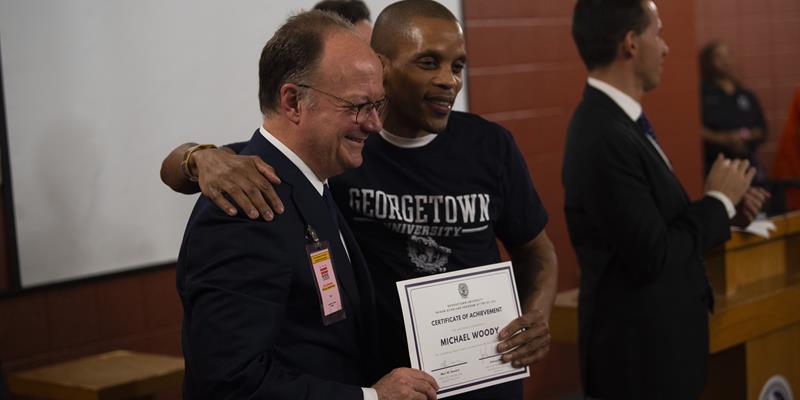The COVID-19 pandemic systemically challenged institutions of higher education. Over the past year, colleges and universities have become even more cognizant of issues surrounding childcare, unreliable broadband access, the need for reliable housing for traditionally underserved students, and other barriers to equity and access. But beyond the established campus, the pandemic severely limited options for students in prison.
After March 2020, college prison programs were forced to either switch to a paper correspondence model or leverage any technology available in the prison facilities to create virtual programming, but many suspended their programs altogether.
According to a
2016 RAND report, 30 percent of federal and state inmates do not have a high school diploma or GED equivalency (compared to 19 percent in the general population), and just 12 percent of the prison population has attained some form of postsecondary education (compared to 48 percent of the general population).
On top of limited access to higher education, prison populations were severely impacted by virus transmission.
Data collected by The Marshall Project and Associated Press found that one in every five state and federal prisoners in the United States has tested positive for the coronavirus, a rate that is four times higher than that of the general population.
According to report from
Ithaka S+R in 2019, it is estimated that of the 1.5 million people in prison, roughly 71,000 are enrolled in a post-secondary education program. One bright spot in the work to provide incarcerated individuals with higher education programming comes from Georgetown University’s
Prison Scholars Program. The program, a segment of the university’s Prisons and Justice Initiative, began offering both noncredit and credit-bearing college courses to more than 150 incarcerated students at the D.C. jail in 2018. In April 2021, the university announced that it will expand to include a liberal arts degree program for incarcerated individuals in Maryland’s state prison system this fall.
An initial cohort of 25 students will represent the first iteration of the degree program at Patuxent Institution, a maximum-security prison in Jessup, MD. Any inmate in the state can apply, and those accepted to the program will be transferred to the Patuxent facility.
Georgetown offers funds from the
Second Chance Pell program, an initiative started by President Barack Obama and expanded under President Donald Trump, a pilot initiative that allowed inmates to use federal financial aid created for other low-income students.
Congress banned Pell for prisoners in 1994 but reversed the ban in December 2020. In a
new blog post for
Higher Education Today, Ruth Delany and Allan Wachendorfer of the Vera Institute of Justice write that lifting the ban will be transformative, shattering “many of the inequities and obstacles associated with reentry that people with low-incomes and communities of color face.”

John J. DeGioia, the president of Georgetown University, posing for a photo with Michael Woody, a graduate of the Prison Scholars Program in 2019. Photos by Lisa Helfert, ©2019 Georgetown University.
While the Second Chance Pell program offers many benefits, Sheila Meiman, director of
Returning and Incarcerated Student Education (RISE) at
Raritan Valley Community College (RVCC) in New Jersey notes that colleges considering establishing prison programs should be aware of the significant administrative requirements involved in applying for federal funds.
RVCC began offering courses in prisons in 2010 and relied primarily on philanthropic funding until 2016 when they could use funds granted by the Second Chance Pell program. While the funding remains immensely helpful, the program ran into some unexpected hurdles trying to assist their students in prison.
“We worked with the Department of Education (ED) to resurrect a paper FAFSA,” she said, noting that college staff members would bring a set of forms to a prison, help inmates fill them out, and take the forms back to the college to enter the data online. RISE administrators also had to work with ED to find other acceptable alternative forms of identification besides a driver’s license or a Social Security card to verify data for inmates without those documents.
Even after that time and additional administrative costs, only about 65 percent of the inmates in RISE are able to get Pell grants.
Other institutions offer more tailored course programs for women. The University of Puget Sound established the
Freedom Education Project Puget Sound (FEPPS) to provide incarcerated women, transgender, and gender-nonconforming people in Washington with access to higher learning.
Since 2016, 46 associate degrees were awarded from this program. In October 2020, the program expanded to offer accreditation for Bachelor of Arts in Liberal Studies. The Andrew W. Mellon Foundation also awarded Puget Sound a $1 million grant to help foster the development of the degree program.
Serving this particular community of the prison population is especially critical since a 2018 study
found that women are the fastest-growing segment of the US prison population. Within the FEPPS program, a survey found that the overwhelming majority of FEPPS students are survivors of domestic abuse and sexual assault, have had minimal access to higher education, and will become full-time caretakers of children under 18 upon release.
Warren Allen, a Georgetown Prison Scholar, reflected on the opportunity to obtain higher education while being incarcerated for 20 years.
“What I mostly got away from it was if I just apply myself, I could be sufficient in life. If I just work a little harder, I get a little more out of life. If I just raise my hand and say, ‘I need some help,’ I get the help I need in life. And from that, I got confidence,” Allen said. “Overall, what I got from the program was confidence. I’ve gained confidence in myself. I believe in myself. But it all was a process.”